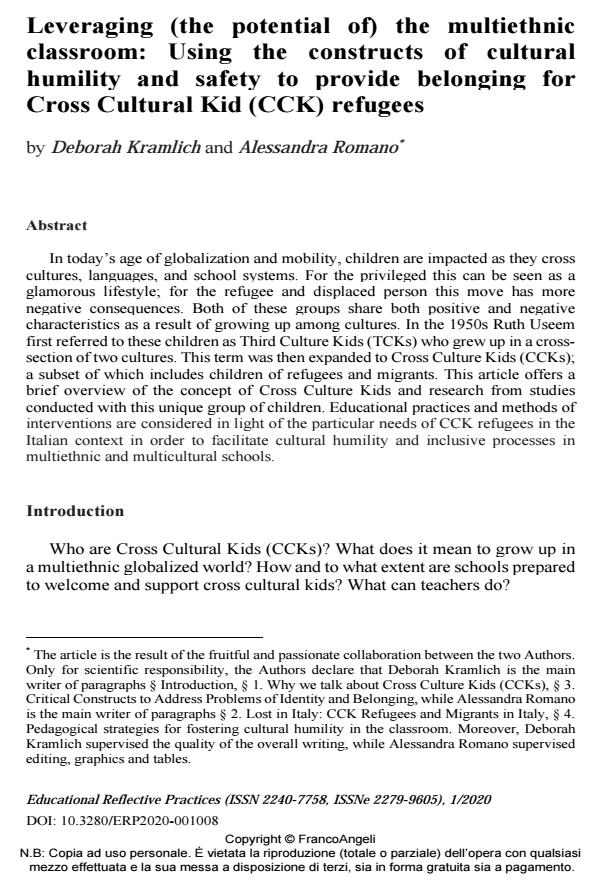Leveraging (the potential of) the multiethnic classroom: Using the constructs of cultural humility and safety to provide belonging for Cross Cultural Kid (CCK) refugees
Titolo Rivista EDUCATIONAL REFLECTIVE PRACTICES
Autori/Curatori Deborah Kramlich, Alessandra Romano
Anno di pubblicazione 2020 Fascicolo 2020/1
Lingua Inglese Numero pagine 33 P. 146-178 Dimensione file 452 KB
DOI 10.3280/ERP2020-001008
Il DOI è il codice a barre della proprietà intellettuale: per saperne di più
clicca qui
Qui sotto puoi vedere in anteprima la prima pagina di questo articolo.
Se questo articolo ti interessa, lo puoi acquistare (e scaricare in formato pdf) seguendo le facili indicazioni per acquistare il download credit. Acquista Download Credits per scaricare questo Articolo in formato PDF

FrancoAngeli è membro della Publishers International Linking Association, Inc (PILA)associazione indipendente e non profit per facilitare (attraverso i servizi tecnologici implementati da CrossRef.org) l’accesso degli studiosi ai contenuti digitali nelle pubblicazioni professionali e scientifiche
In today’s age of globalization and mobility, children are impacted as they cross cultures, languages, and school systems. For the privileged this can be seen as a glamorous lifestyle; for the refugee and displaced person this move has more negative consequences. Both of these groups share both positive and negative characteristics as a result of growing up among cultures. In the 1950s Ruth Useem first referred to these children as Third Culture Kids (TCKs) who grew up in a cross-section of two cultures. This term was then expanded to Cross Culture Kids (CCKs); a subset of which includes children of refugees and migrants. This article offers a brief overview of the concept of Cross Culture Kids and research from studies conducted with this unique group of children. Educational practices and methods of interventions are considered in light of the particular needs of CCK refugees in the Italian context in order to facilitate cultural humility and inclusive processes in multiethnic and multicultural schools.
- La Student Measure of Culturally Responsive Teaching scale: adattamento e validazione per il contesto universitario italiano Nicolina Bosco, Loretta Fabbri, Mario Giampaolo, in EXCELLENCE AND INNOVATION IN LEARNING AND TEACHING 1/2022 pp.39
DOI: 10.3280/exioa1-2022oa13935 - Stay humble and enjoy diversity: The interplay between intergroup contact and cultural humility on prejudice Marika Rullo, Emilio Paolo Visintin, Stella Milani, Alessandra Romano, Loretta Fabbri, in International Journal of Intercultural Relations /2022 pp.169
DOI: 10.1016/j.ijintrel.2022.02.003 - Humble and Kind: Cultural Humility as a Buffer of the Association between Social Dominance Orientation and Prejudice Emilio Paolo Visintin, Marika Rullo, in Societies /2021 pp.117
DOI: 10.3390/soc11040117
Deborah Kramlich, Alessandra Romano, Leveraging (the potential of) the multiethnic classroom: Using the constructs of cultural humility and safety to provide belonging for Cross Cultural Kid (CCK) refugees in "EDUCATIONAL REFLECTIVE PRACTICES" 1/2020, pp 146-178, DOI: 10.3280/ERP2020-001008